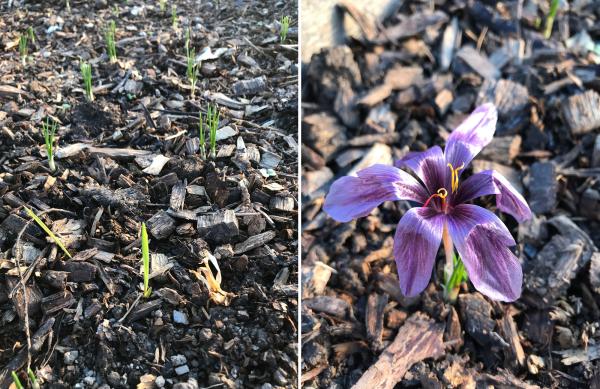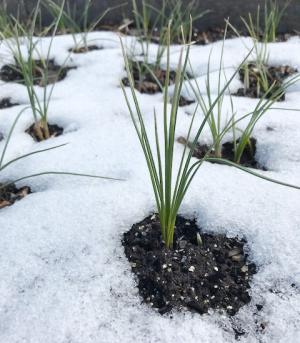Such a unique plant, no wonder its food and health qualities are valued around the World. I hope this grand experiment works. If so, you can dry it and sell an exclusive amount, with the Shelburne Farms logo at the Visitors Center! Vermont grown Saffron!
Gorgeous Blossom. Thank you for this treat.
Sincerely,
JPM
This season (although it really started last season), we're experimenting with growing saffron at the Market Garden.
Saffron is a spice. It is one of the most expensive food products in the world, because the harvesting process is so labor intensive.
The bright red-orange threads that people purchase are actually the stigmas (female portion) of the saffron crocus flowers. Each flower only has three stigmas, so about 150 flowers are needed to produce one gram of saffron.
The "seed" of the idea for our project was planted by Elias, a seasonal employee last year. Elias' father, Paul Wieczoreck, is a horticulturist, and he gave us some saffron bulbs last fall. We planted them then, and got a few blossoms in November, but because that was our first planting, we didn't do any harvesting.
The saffron crocus has an interesting life cycle (which is why it's harvested in the fall). In late winter or early spring, leaves emerge from the bulb, but there's no flower. Then, once temperatures heat up, the bulb actually goes dormant and the leaves die back. New leaves form in September when the temperature cools. Then the saffron crocus blooms in the fall and is harvested.
The best time to harvest stigmas is in mid-morning, on a sunny fall day, when the flowers are fully open. We plan to harvest the stigmas with our fingers -- or maybe tweezers. Then we will put them in a warm place to dry. (We have to research and experiment with all this when the time comes.)
It is always exciting to try growing new plants at our organic Market Garden. It allows us to experiment with and display the wonderful variety of foods that can be grown in Vermont.
If we're successful in growing, harvesting, and drying the saffron, we'll send it to Chef Jim at the Inn restaurant. He tells us that saffron is absolutely essential for paella, is great to incorporate into fresh pasta (it gives the pasta a magnificent color and interesting flavor), and goes well in vinaigrettes, especially in summer when the Inn tries to incorporate a lot of fresh flowers into the salads.
We’ll keep you updated on “Project Saffron!”
Here are a few sources we've found helpful:
https://www.whiteflowerfarm.com/how-to-harvest-saffron-crocus
https://www.gardeningknowhow.com/edible/herbs/saffron/saffron-harvesting-information.htm
http://www.gardenersworld.com/how-to/grow-plants/how-to-grow-saffron/
Comments
If it ever gets to be a sizable crop you're gonna need a lot of interns or volunteers. IIRC, UVM did some studies on this 18-24 months ago. Assuming coupe grade (the highest) saffron at $8.50 per gram (retail price) divided by 150 flowers that makes each flower worth roughly 6 cents. Each stigma would be worth about 2 cents. At $10/hr labor cost (VERY optimistic) the break even number on the highest possible retail price saffron means each worker needs to harvest 500 HUNDRED stigmas per hour, or roughly 167 flowers. That means about three flowers/nine stigmas a minute for the entire hour. This scenario also assumes best case on the number of stigmas per flower, labor cost and final price, as well as leaving out labor and costs for drying and packaging, never mind the cost of bulbs, fertilizer, land lost to other crops, etc... It's not entirely hopeless though. https://www.researchgate.net/publication/270916668_Autonomous_Vehicle_f… gives some hope and more accurate numbers than mine on the realities of saffron harvesting. Then there's always the potential for "value added" products such as saffron oil, saffron shallot pickles, saffron cocktails, saffron crocus bulbs in the gift store, and so forth. Still, without new technology, I would guess it will be financially unsustainable, even if it is a boon to the folks who dine at the inn.


